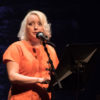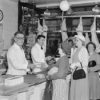The History Lesson
This week back in 1958, a waterway about 150 miles from Vancouver was ground zero for an unusual moment in Canadian history. The story starts dramatically. With an underwater mountain called Ripple Rock. It sat smack in the middle of a shipping route and its peak was just nine feet below the surface. Ships would get their hulls ripped open. More than 100 people drowned. Sailors called it the most deadly stretch of water in North America. Clearly “Ripple Rock” had to be blown up.
Two problems, though: It’s kinda tough to put explosives on an underwater mountain surrounded by crazy currents and whirlpools. And once you do? Its hard to make the explosives actually — detonate. For 15 years, Ripple Rock refused to be destroyed.
Finally, engineers hatched a plan. They’d dig a tunnel down into a nearby island, then dig horizontally over to Ripple Rock, then dig up into the mountain and plant the explosives inside. Like, a lot of explosives. Enough to make it the biggest non-nuclear peacetime explosion in history.
For Canucks, it was the event of the century. Canadian TV broadcast live from the scene. Residents in a three mile radius were evacuated. Rumors abounded the blast might set off an earthquake. The results? Well, sailors were happy — the explosion left Ripple Rock 40 feet shorter, and boats now pass safely. For those expecting hell on Earth? It was a let down. Debris from the blast didn’t get much further than the shore, locals didn’t hear or feel a thing. And even fish escaped mostly unharmed. Canadians, ever polite, scheduled the blast for April — when local salmon were away on migration.
The Booze
The Detonator

Mixed by Jay Jones at the Pourhouse in Vancouver, BC.
Ingredients:
In a shaker add:
- 1 ½ ounce Knob Creek
- Splash of Fernet
- Fresh lemon juice
- Dash of simple syrup
Instructions:
Add ice, shake and strain into a chilled champagne coupe. Top with champagne. Peacefully destroy any social obstacle which comes between you and happiness.


